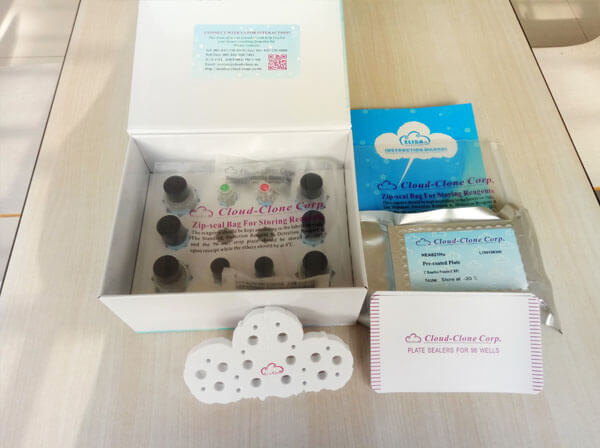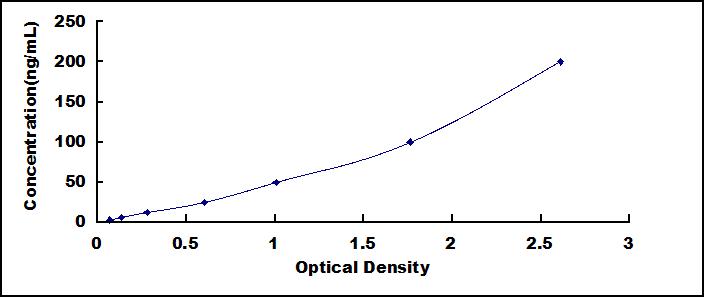ELISA Kit for Anti-Insulin Receptor Antibody (Anti-INSR) 

CD220; ISR; HHF5; IR
- UOM
- FOB US$ 588.00 US$ 840.00 US$ 3,780.00 US$ 7,140.00 US$ 58,800.00
- Quantity
Overview
Properties
- Product No.AEA895Hu
- Organism SpeciesHomo sapiens (Human) Same name, Different species.
- ApplicationsEnzyme-linked immunosorbent assay for Antibody Detection.
Research use only - DownloadInstruction Manual
- CategorySignal transductionEndocrinologyAutoimmunity
Sign into your account
Share a new citation as an author
Upload your experimental result
Review

Contact us
Please fill in the blank.
Recovery
Matrices listed below were spiked with certain level of Anti-Insulin Receptor Antibody (Anti-INSR) and the recovery rates were calculated by comparing the measured value to the expected amount of Anti-Insulin Receptor Antibody (Anti-INSR) in samples.
| Matrix | Recovery range (%) | Average(%) |
| serum(n=5) | 91-105 | 99 |
| EDTA plasma(n=5) | 88-103 | 96 |
| heparin plasma(n=5) | 85-99 | 92 |
Precision
Intra-assay Precision (Precision within an assay): 3 samples with low, middle and high level Anti-Insulin Receptor Antibody (Anti-INSR) were tested 20 times on one plate, respectively.
Inter-assay Precision (Precision between assays): 3 samples with low, middle and high level Anti-Insulin Receptor Antibody (Anti-INSR) were tested on 3 different plates, 8 replicates in each plate.
CV(%) = SD/meanX100
Intra-Assay: CV<10%
Inter-Assay: CV<12%
Linearity
The linearity of the kit was assayed by testing samples spiked with appropriate concentration of Anti-Insulin Receptor Antibody (Anti-INSR) and their serial dilutions. The results were demonstrated by the percentage of calculated concentration to the expected.
| Sample | 1:2 | 1:4 | 1:8 | 1:16 |
| serum(n=5) | 79-101% | 79-92% | 79-104% | 94-102% |
| EDTA plasma(n=5) | 84-98% | 99-105% | 84-103% | 95-104% |
| heparin plasma(n=5) | 92-101% | 95-105% | 89-97% | 94-102% |
Stability
The stability of kit is determined by the loss rate of activity. The loss rate of this kit is less than 5% within the expiration date under appropriate storage condition.
To minimize extra influence on the performance, operation procedures and lab conditions, especially room temperature, air humidity, incubator temperature should be strictly controlled. It is also strongly suggested that the whole assay is performed by the same operator from the beginning to the end.
Reagents and materials provided
| Reagents | Quantity | Reagents | Quantity |
| Pre-coated, ready to use 96-well strip plate | 1 | Plate sealer for 96 wells | 4 |
| Standard | 2 | Standard Diluent | 1×20mL |
| Detection Reagent A | 1×120µL | Assay Diluent A | 1×12mL |
| TMB Substrate | 1×9mL | Stop Solution | 1×6mL |
| Wash Buffer (30 × concentrate) | 1×20mL | Instruction manual | 1 |
Assay procedure summary
1. Prepare all reagents, samples and standards;
2. Add 100µL standard or sample to each well. Incubate 1 hours at 37°C;
3. Aspirate and add 100µL prepared Detection Reagent A. Incubate 1 hour at 37°C;
4. Aspirate and wash 5 times;
5. Add 90µL Substrate Solution. Incubate 10-20 minutes at 37°C;
6. Add 50µL Stop Solution. Read at 450nm immediately.

Test principle
The microtiter plate provided in this kit has been pre-coated with an antigen. Standards or samples are then added to the appropriate microtiter plate wells with a Horseradish Peroxidase (HRP)-conjugated secondary antibody. After TMB substrate solution is added, those wells that contain Anti-Insulin Receptor Antibody (Anti-INSR) will exhibit a change in color. The enzyme-substrate reaction is terminated by the addition of sulphuric acid solution and the color change is measured spectrophotometrically at a wavelength of 450nm ± 10nm. The concentration of Anti-Insulin Receptor Antibody (Anti-INSR) in the samples is then determined by comparing the O.D. of the samples to the standard curve.
Giveaways
Increment services
Citations
- Molecular and Biochemical Effect of Neem Extract On Experimental Diabetes Org:Source
- Age-Dependent Onset of Insulin Resistance in Insulin-Resistant MicePubMed: 26632184
- A newly developed silymarin nanoformulation as a potential antidiabetic agent in experimental diabetespubmed:27623396
- Subcutaneous liraglutide ameliorates methylglyoxal-induced Alzheimer-like tau pathology and cognitive impairment by modulating tau hyperphosphorylation and glycogen synthase kinase-3β.pubmed:28337257
- Vitamin D3 intake as regulator of insulin degrading enzyme and insulin receptor phosphorylationin diabetic rats.pubmed:27930980
- Regulation of insulin receptor phosphorylation in the brains of prenatally stressed rats: New insight into the benefits of antidepressant drug treatment.pubmed:28063625
- (台灣農業研究67 (4): 355-364) 香菇柄水萃物改善糖尿病降低阿茲海默氏症罹病風險初探
- Mechanism underlying starvation-dependent modulation of olfactory behavior in Drosophila larvaPubmed: 32080342
- Prenatal Stress Induced Spatial Memory Deficit in a Sex-Specific Manner in Mice: Possible Involvement of Hippocampal Insulin Resistance
- Internal State Affects Local Neuron Function in an Early Sensory Processing Center to Shape Olfactory Behavior in Drosophila Larvae















